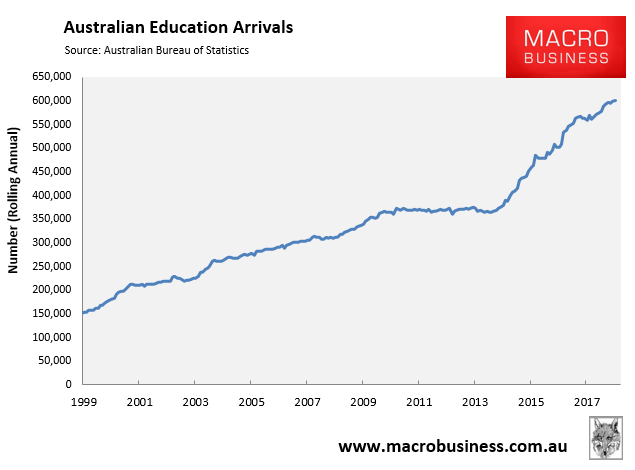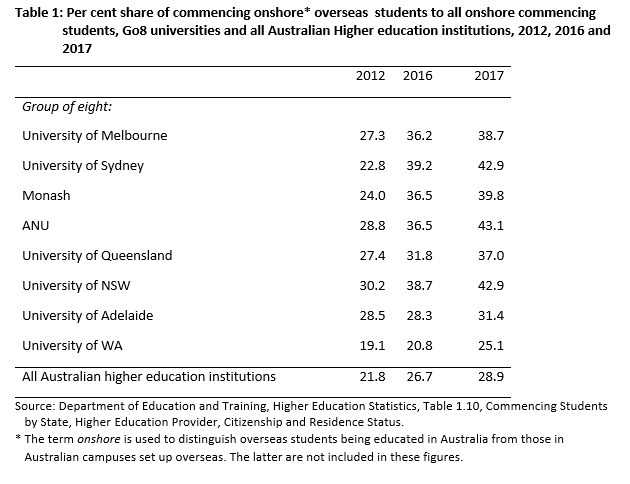After a near doubling of international student arrivals over the past five years:

The Victorian Government last month called for a review of entry requirements into Australian universities after growing evidence had emerged that foreign students with poor English language proficiency are badly eroding education standards and placing undue strain on lecturers and university staff.
This was immediately followed by academics admitting to Fairfax that they had lowered teaching standards and passed failing international students in order to maintain the foreign student trade.
The international student association also called for greater regulation of overseas migration agents amid widespread cheating on English tests to gain access to Australian universities.
Last week, practising psychiatrist, Tanveer Ahmed, penned an article in The AFR claiming that international students “obtain degrees of limited value and are consigned to low-skilled work”:
Wages are depressed for the majority of low and semi-skilled workers…
Many international students also obtain degrees of limited value and are consigned to low-skilled work… they make up a large chunk of the service worker underclass. They are not captured in the unskilled category. A 2017 study by training company Hobsons found only 34 per cent of workplaces were willing to take a risk on international graduates.
Natives have the opportunity to take jobs that make use of their superior English, whereas low-skilled migrants compete against other migrants at the bottom end of the labour market.
Whereas over the weekend, The Australian’s Judith Sloan argued that the cost of Australia’s turbo-charged international student market probably outweighs the purported $36 billion of annual export earnings:
Let me run through some of the costs of international students that are often ignored — indeed, often denied. They include the impact on educational standards, the potential for international students to be exploited in the labour market, the real motivation of students to gain permanent residence, and the dubious practices of some migration agencies.
…let us look at the research undertaken by economist Gigi Foster, who was given access to the records of students, both local and international, at the University of South Australia and UTS. Note her research was published in a peer-reviewed journal.
The question that Foster was trying to answer was: do more international students affect educational standards? What she found was that international students do consistently worse than local students but because students are marked according to the curve (in large courses, at least), international students do better when there are fewer local students in a course. This is because there are fewer local students to occupy the top end of the distribution of marks.
She also looked at tutorial performance and found that local students do worse in tutorials with more international students. Foster concludes that there is clear evidence of a dumbing down of courses because of poor language skills of international students…
We also know from the work of the Fair Work Ombudsman that there are many cases of underpayment of low-skill workers. Often these workers are on student visas and the maltreatment is perpetrated by businesses whose owners were also born overseas…
As MB has argued repeatedly, Australia’s universities have morphed from “higher learning” to “higher earning”, as evidenced by the massive explosion in full fee-paying foreign students:

Australia’s education system has become an integral part of the immigration industry and the ‘Big Australia’ population ponzi – effectively a way for foreigners to buy backdoor permanent residency and working rights.
Even the lobby group representing foreign students in Australia – the Council for International Students in Australia (CISA) – point blank admitted that students come here to migrate, not because of the quality of education on offer:
The Council for International Students in Australia said foreign potential students were attracted to Australia by the possibility of migrating here.
But Mr Dutton’s strong views on border policy and his statement that Australia should reduce its intake of migrants “where we believe it is in our national interest” would tip the balance for some would-be students…
The national president of CISA, Bijay Sapkota, said… “For people coming from low socio-economic backgrounds there has to be a value proposition. If they go home they will not get value. So there has to be a possibility of immigration.”
Three recent Australian reports (here, here and here) have similarly raised the alarm about the flood of international students and the degradation of standards, but have been attacked by the rent-seeking Universities Australia.
Dr Cameron Murray – an economics lecturer at the University of Queensland – also highlighted the problem in detail, which supports Judith Sloan’s arguments:
A thread on my experience:
1. 90% of students in my economics masters classes are international.
2. Half of them struggle with basic English
3. When I ask in tutorials why they are doing the degree, half tell me that they “need more points for their residency visa” (1/n)
4. They tell me they choose economics because they can do the maths but don’t need to understand anything or write anything.
5. I always set written essays or reports. Students tell me that they know other students are using paid ‘essay writing’ services to pass my class (2/n)
6. If half the class can’t understand English it brings down standards. It must—unless I fail half the class.
7. Think about the incentives—a casual lecturer who costs $25,000 fails 50 students paying $250,000. Change lecturer next year or reduce intake to keep standards? (3/n)
8. It is frustrating when top international students from foreign governments/central banks come to your class, then sit next to rich Chinese (almost always Chinese) who can’t understand a word and are there to buy a visa (4/n)
9. The evidence shows the effect on standards is real. https://www.sciencedirect.com/science/article/abs/pii/S027277571200028310
None of this is a secret. That research is from 2011. Here’s an article from 2014: https://www.smh.com.au/education/academics-accuse-universities-of-addiction-to-international-students-and-their-cheating-20141112-11lbdi.html
10. Unfortunately, this reality conflicts with the widely believed myth that our immigration program brings in “high skilled” workers.
11. 350,000 international students paying $25,000+ per year to study is $9billion being pumped through our top dozen universities. (6/n)
12. Halving the number of international students would keep all the good students, boost standards for all, and remove the visa scams.
13. But this would remove $4.5billion per year of revenue to the universities. (7/n)
14. In sum, universities are being degraded so they can be used as a back-door immigration program, and no one at the senior levels of universities or major political parties want to change it.
15. It is nearly career suicide for younger academics to say anything about it (8/8)I forgot to add that almost every student I failed or called out for plagiarism got second and third chances until they passed. After the first chance it is taken out of my hands to higher ups at the faculty…
There is nothing new in this thread.
@4corners did a big investigation a few years ago. Nothing changed AFAIK. People are just used to the new reality. https://economics.com.au/2015/04/17/universities-corruption-and-standards-its-not-just-academic-anymore/More here: https://www.theaustralian.com.au/higher-education/free-ride-past-language-barrier/news-story/9082a4d2234f019af2ddd1f68be73a8f and here: https://economics.com.au/2011/03/16/are-we-going-easy-on-foreign-students-in-order-to-get-more-revenue/
The sad reality is that Australia’s universities are little more than giant rent-seeking businesses that clip the ticket on the deluge of foreign students arriving in the hope of transitioning to permanent residency. The end result has been the dumbing-down of standards and too many university graduates chasing too few professional jobs.
The universities love this set up as they get to maximise fees and profit, and privatise the gains from Australia’s immigration system. By contrast, the broader community wears the costs.
At the same time as Vice-chancellors’ pay has exploded to an average of $1 million on the back of the student flood, university students are stuck paying off expensive and increasingly worthless degrees, taxpayers are stuck writing-off unpayable debts, and the broader population is suffering under the never-ending population crush.
Policymakers must place a firm leash on the university sector, starting with removing the link between foreign students studying at university and gaining work visas and permanent residency. Australia’s universities must be forced to compete on quality and value alone, not as a backdoor pathway for immigration.

